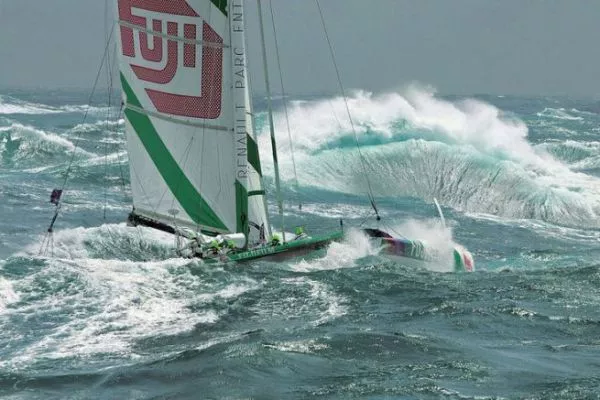Examining Rogue Waves: Nature’s Enigmatic Giants
Rogue waves, often depicted in maritime legends, are massive waves that appear unexpectedly and can unleash devastating force. Scientists have made significant strides in understanding these formidable phenomena, shedding light on their characteristics and behaviors.
The Historical Perspective on Rogue Waves
Throughout history, reports from sailors, including famous navigators like Christopher Columbus, have included accounts of alarming wave heights. A primary challenge arose from the inability to measure these immense waves accurately, leading scientists to initially dismiss them as mere exaggerations. However, developments in technology during the mid-20th century began to reveal a grain of truth behind the legends. This shift marked the beginning of serious scientific inquiry into the rogue wave phenomenon.
First Confirmed Measurement
The first confirmed measurement of a rogue wave took place on January 1, 1995, at the Draupner oil platform in the North Sea. Equipped with advanced measurement technology, the platform recorded a wave towering at an astonishing height of 26 meters, while the surrounding average waves were only 12 meters high. This groundbreaking moment officially established the existence of rogue waves, often referred to as Draupner waves.
Understanding Rogue Wave Characteristics
Rogue waves are characterized by their unique properties; they tend to be at least double the height of surrounding waves and typically have a brief lifespan of about 20 seconds. This phenomenon can occur both in calm waters and during storms, making it a fearsome challenge for sailors. For instance, in the illustration below, the intricate relationship between rogue waves and typical sea conditions is elaborated:
| Description | Height |
|---|---|
| Supertanker (460 meters long) | N/A |
| Standard storm wave | 12 meters |
| Rogue wave | 30 meters |
The Formation of Rogue Waves
Scientists have made immense progress in demystifying the formation of rogue waves. Research indicates that they involve energy absorption from surrounding wave patterns, essentially resulting from constructive interference. A Scottish research team successfully recreated conditions that spawn rogue waves in a controlled laboratory setting. They observed that when two wave fronts intersect at a crucial angle, rogue waves are born.
Implications for Navigation
With the scientific community’s growing understanding of rogue waves, the potential for developing navigation software that anticipates such phenomena is on the horizon. Many mariners are familiar with the term “cross sea,” often deemed hazardous. By integrating insights from rogue wave research into navigation systems, it might be possible to enhance the safety of yachting and sailing expeditions.
Consequences of Rogue Waves
Rogue waves can have catastrophic consequences, having caused various shipwrecks and accidents at sea. For instance, a typical 3-meter high wave exerts about 6 tonnes per square meter, while a rogue wave of 30 meters could exert pressures reaching up to 100 tonnes per square meter. Currently, no vessel is built to withstand such extreme forces, which only emphasizes the importance of understanding these phenomena.
The Visual Representation of Rogue Waves
Research teams have visualized the formation of rogue waves, providing fascinating comparisons to artistic representations, such as Hokusai’s “The Great Wave off Kanagawa.” Such art captures not only the terror but also the beauty of these majestic water giants.
The Coastal Adventure of Sailing: Embracing the Elements
Visitors to marinas often find themselves enchanted by the open water, longing to explore the vast ocean. Experiencing a rogue wave puts a unique spin on the adventure of sailing, deepening one’s respect for the sea. It’s essential to stay informed about the latest in sea conditions and developments in maritime science through resources that understand the thrill of oceanic exploration, such as GetBoat.
By observing the intricate connections between rogue waves and typical sailing conditions, seafarers can better prepare for their journeys. When you rent a boat, contemplate the challenges that the ocean may throw your way and enhance the adventure of your coastal trips.
Why Choose GetBoat for Your Next Adventure?
At GetBoat, we appreciate the thrill of the sea and the allure of underwater adventures. The service aims to provide you with choices that align with your aspirations for freedom and exploration. A selection of vessels awaits you, tailored to suit any budget and preference, fostering unforgettable experiences on the water.
Conclusion: Navigating the Exotic Waters of Adventure
Whether faced with rogue waves or smooth sailing, the experience of engaging with the ocean is rich and multifaceted. Embracing new locations and their inherent culture, cuisine, and community makes for unforgettable stories, drawing us deeper into the essence of life at sea. As you plan your next seaside adventure, consider renting a boat to uncover the hidden gems each inlet and bay offers, creating memories that rival those borne from local cuisine and architecture. For an experience that ensures transparency and convenience, visit GetBoat.com.
The integration of rogue wave research into everyday sailing practices confirms that, while adventurers seek the thrill of the vast unknown, they become more grounded with knowledge about their environment. Continue to explore the wonders that await at sea, knowing that through GetBoat, every sailing journey promises excitement and discovery.

 Unraveling the Mystery of Rogue Waves">
Unraveling the Mystery of Rogue Waves">
